Feet of Clay
This week: Feet of Clay; Weather and climate; Precipitation; The Brown Willey Effect; Understanding the forecast; Moving water around;

It’s Saturday morning and I have the lights on. Black clouds stretch from horizon to horizon.
The rain is coming down, the felines have decided their beds are MUCH nicer than the outdoors. They have way more sense than I. So I’m tidying up the text before posting this week’s missive later today.
Do you remember waiting for Christmas Day? When I was growing up, I remember the tree in the corner of the lounge at home. The presents wrapped waiting under its branches to be opened on Christmas morning.
Here in Croatia there is no tradition of sending Christma cards. So when I was asked this week by my Dad how many cards had the postman brought, the answer is truthfully “None”.
True, I have received a couple of electronic cards, but I don’t print them. I recall receiving 40 or more cards annually, when I lived in the UK. It keeps the postmen busy at this time of year I suppose…
Equally, there is no tradition of exchanging gifts. However, that doesn’t stop me from taking a nice card and a box of biscuits round to my near neighbours on Christmas Eve.
These are the good folk who throughout the year share coffee (or Rakija) and stories; offer a helping hand when the chain saw is running a little roughly; bring bottles of their new, extra virgin olive oil and/or wine. Neighbours are important people.
So it’s nice to share a northern European tradition here in the far south east of Europe. But what I discovered this week is that for all the past ** years [** insert number as applicable] we have been wrapping parcel all wrong.
There is a science to how to gift wrap properly – like most things thee days. So this afternoon, presuming the wet stuff is still falling from the sky, I’ll be trying it out.
Merry Christmas everyone!
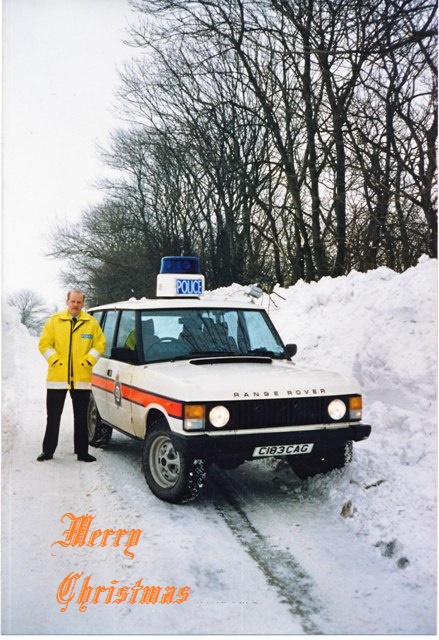
Feet of Clay
I had a reputation in the service as an innovator. But I did tell the Deputy Chief one day, at our regular helicopter support management board meeting, that of the 100 ideas we try, it is only the 1 which is a success that I report on!
It’s much the same here in Dol. Last spring I grew some sweet potato “slips”. Sweet potato is a seasonal vegetable, but I had a spare corner in the top orchard, so thought I would fill it.
These were not the usual variety though. I had found some Purple Yams in the supermarket and thought I would try growing them.

I propagated and planted four slips and watched them sprout, grow and spread. As the summer wore on, I kept them watered, as this area of the orchard dried out. Yams and sweet potatoes are similar in growth habit and appearance. However they are actually completely different plants, although they share the same growing conditions.
Sweet potatoes are a spreading vine, and their leaves smother everything else. That was the idea, fill a corner with a weed suppressing mat and harvest the produce later.
I have watched and waited for flowers. but none came. In previous years I’ve grown sweet potatoes in the top orchard and harvested more than I could eat. I’ve had flowers too, large, showy and reminiscent of Convolulus.
I saw this week that the leaves had died back. They are tropical after all, and whist it is much warmer than normal for the time of year, you could not describe the nights as “tropical”. So I started to gently lift the soil around the growing head of each plant.

The result? Nothing: Nada: Nema: Zilch!
On the roots there were swellings where tubers were clearly forming, but no tubers. I had also planted a regular red sweet potato and when I dug that up, there a were a couple of big tubers – at least enough to eat – but nothing like the number I have had in the past.

I remembered that one of the common names is “ten month yam”, referring to the length of time it takes for them to grow. So may be I have harvested them a little early.
I have left one plant in place, which I’ll cover and protect from the winter cold and see if the tubers develop to a harvestable size.
It could be that it has just too dry and hot this summer and they need different growing conditions. I need to investigate further, but it does show that I have feet of clay, just like everyone else…
Weather and climate
What is the relationship between weather and climate? Climate is the big picture, the macro events caused by shifts in ocean currents; the changing seasons; an El Niño event.
Weather is what we experience hour by hour, day by day.
For me both are important. I’d like to know what climate change has in store for Dol in 2020. Purely selfishly, so I know what I should be planting and more importantly, when.
Weather is important too, so I can plan what I will do tomorrow, in the morning and the afternoon, and the day after, then on successive days. The further ahead you look, the less accurate is the forecast.
So a reader’s question which following my comment in last week’s blog about the 52 litres of precipitation per square meter that we had just experienced, got me thinking.
My weather station uploads data every five minutes, of every day, of every year about the temperature, humidity, dew point, wind speed and direction, precipitation volume and rate (if any), solar UV and soil temperature.
Along with hundreds of thousands of other weather stations around the globe provided by citizen scientists, together with the network of government provided stations, all this data is number crunched to provide forecasts.
I use a data aggregator called Wunderground for my forecasts and it is the most accurate I have found.
For a bigger picture, Windy.com gives a graphical representation of the same data, but over much larger areas. Other people have their favourite sites that they look at for forecasts and at the same time decry the national radio and TV forecasts.
It’s not really fair on the broadcasters because they have 45 seconds to say what is happening across a whole country. The closer you can get to a small forecast area, the more accurate it becomes.
I liked flying in the UK because as a pilot you could telephone the Met Office duty forecaster in Leeds and get a personalised forecast for where you were flying that day. Something farmers can get on payment of a fee but the public have no access to.
Precipitation
Precipitation is the technical term for anything wet that falls from the sky. Rain, hail, snow and sleet are all precipitation, even though they may not reach ground in a liquid state. But their sum total adds to the wetness of the land.
Currently in Dol I have recorded 1,042 liters per square meter since January 1st. But it has been far from evenly spread, with several deluges and weeks of drought.
There are no permanently running water courses on the island, although it was not always so. In Dol, down towards Stari Grad, there is the remains of a water mill.
There must have been a sufficient flow of water at some time to make building a watermill a viable project. There are two substantial dams built by Austrian engineers in the late 19th century, close to my home.

Constructed across a steep valley which drains the island’s central escarpment, they are imposing structures which once must have held back huge quantities of precipitation.
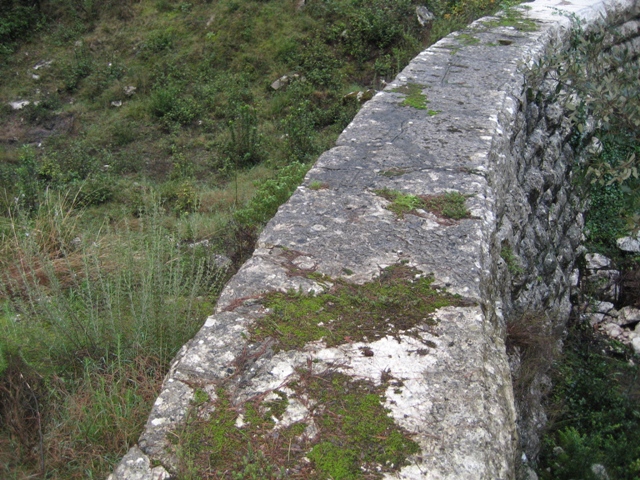
They were a flood prevention measure, to hold water back, so the fields downstream were not washed away during heavy rains. They are now both dry and unused.
But as this year has shown, across Europe we can have lengthy torrential downpours linked to a wildly thrashing upper jetstream. So the ability to take “open source” information, from your own very local area, and then to start to predict flooding events would be useful, especially if you live in a valley bottom or on a flood plain.
I have always had an interest in Meteorology, thanks to my Dad, an RAF pilot, teaching me about clouds from being a toddler. One of my first weather books was the Observer’s Book of Weather.
The Observers Series of 100 detailed pocket size guides were published between 1937 and 2003 by Frederick Warne & Co. I have 20+ in my bookcase today, but one image from the Book of Weather has always stayed with me.
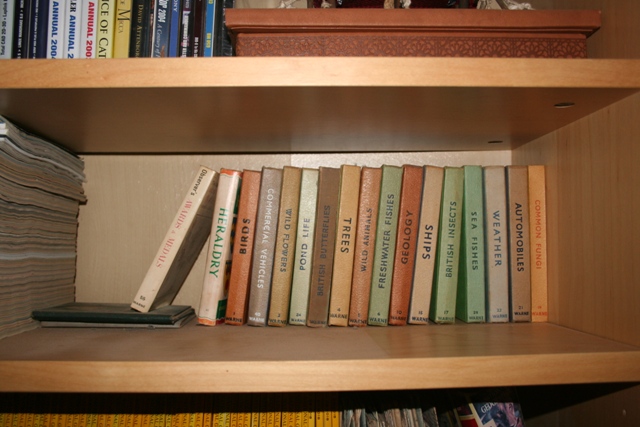
On 15th August 1952, a ferocious storm broke over Exmoor in the south west of England. 229 mm / 9 inches of rain fell in 24 hours, onto an already sodden moorland.
This quickly ran off, swelling brooks into raging torrents and it was funnelled down steep valleys to the sea. At the end of he West Lynn Valley, the town of Lynmouth bore the brunt, with 34 people killed, 28 bridges destroyed along with 100 buildings in the flood.
My Observer’s weather book shows an artist’s painting of the storm over Exmoor.
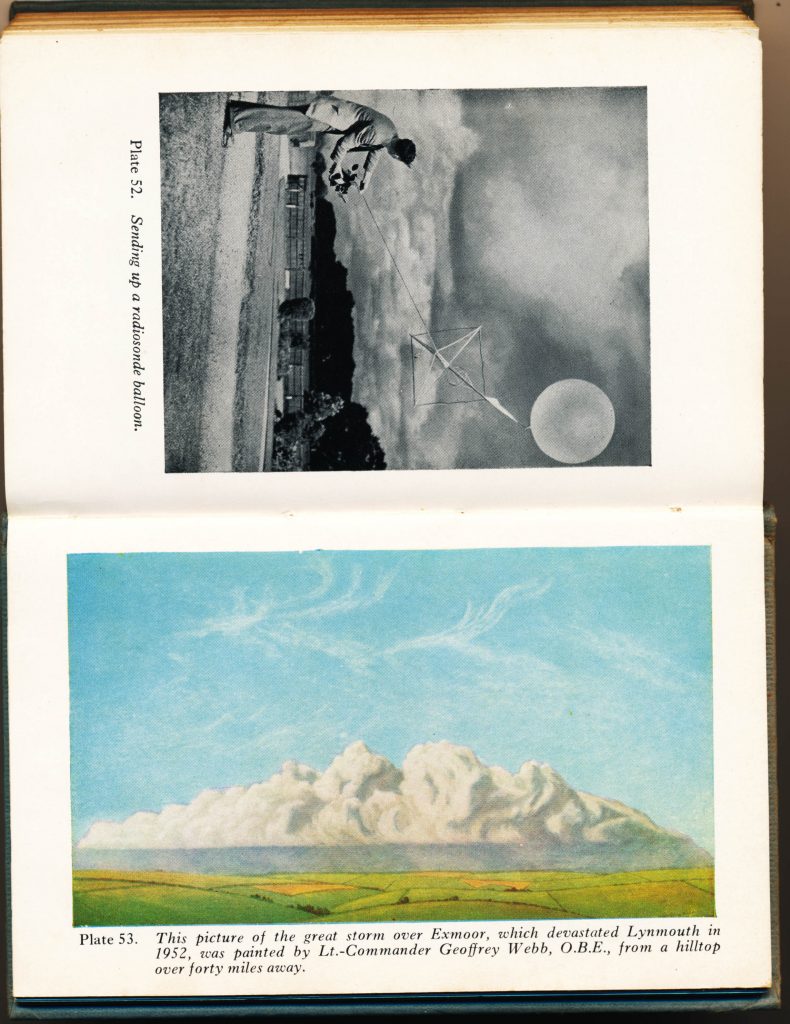
52 years to the day later, the town of Boscastle in Cornwall suffered a similar fate. There was much damage but no fatalities. 200 mm of rain in a localised storm was recorded as having fallen above the town.
The Brown Willey Effect
Local topography has a huge effect on local weather. Travelling aroud the island during the year, I will regularly see lines across the road, where on one side it is bone dry and on the other extremely heavy localised precipitation has fallen.
Another weather station in Stari Grad records significant differences in temperature and precipitation values, even though we are just 2.9 kilometres apart.
In Cornwall it is called the Brown Willy effect (no, seriously!)
Brown Willy is the highest point in the County of Cornwall, with an elevation of 420m/1,380ft. But it’s proximity to the sea and the steep rise from sea level to the summit means that when weather approaches from some directions, the effects can be seen and felt for up to 200 kilometres down wind.
The wrong combination of barometric pressure, moisture laden air, temperature, humidity, dew point, wind strength and direction can cause extremely heavy localised precipitation. If you live down stream from a similar physical feature, have some sand bags filled ready…
Water of course follows the laws of gravity and flows downhill. Here on the Limestone island of Hvar, it seeps between the porous rocks, running downhill to emerge at the only permanent fresh water on the island at Dračevica.
Off shore you can sometimes see huge upwellings of fresh water when you are on the ferry to Split. Fresh water is less dense than sea water and eventually it bubbles out of under sea fissures to reach the surface and be visible.
I have a vein of soft yellow sand and sandstone running through my land. This is even more porous than limestone.
I watch thunder storms pass the island. The island topography splitting the storms so much needed summer rain falls at sea and the soils of Dol remain parched.
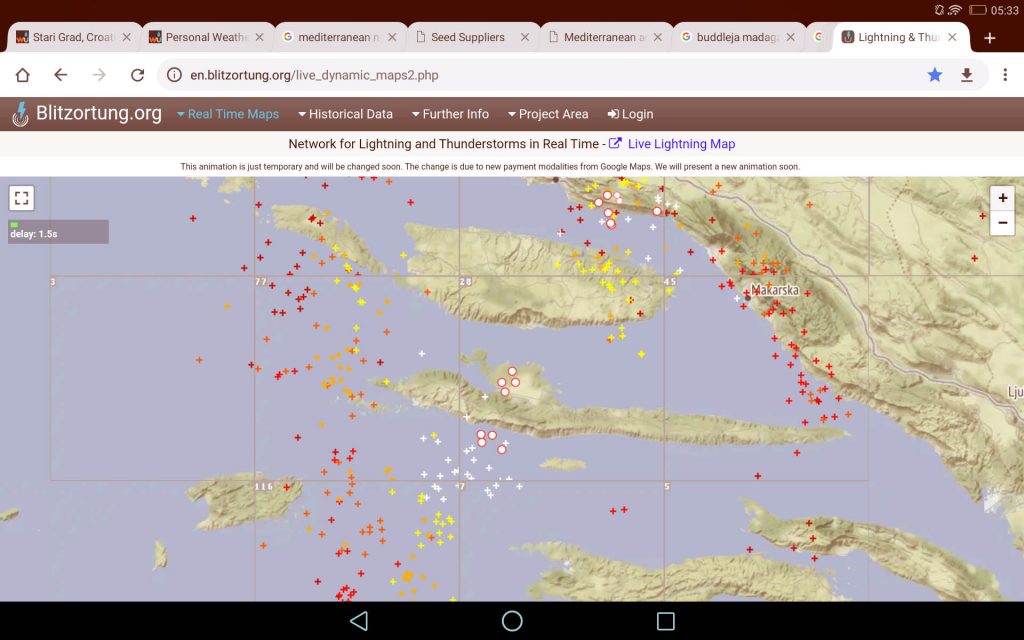
The effect of wind, sea temperature, the topography and the diurnal cycle all mean that no two weather events are exactly the same. But trying to work out what will happen next is still worth doing…
Understanding the forecast
For most people, the weather forecast is just so they have a general idea of what to expect.
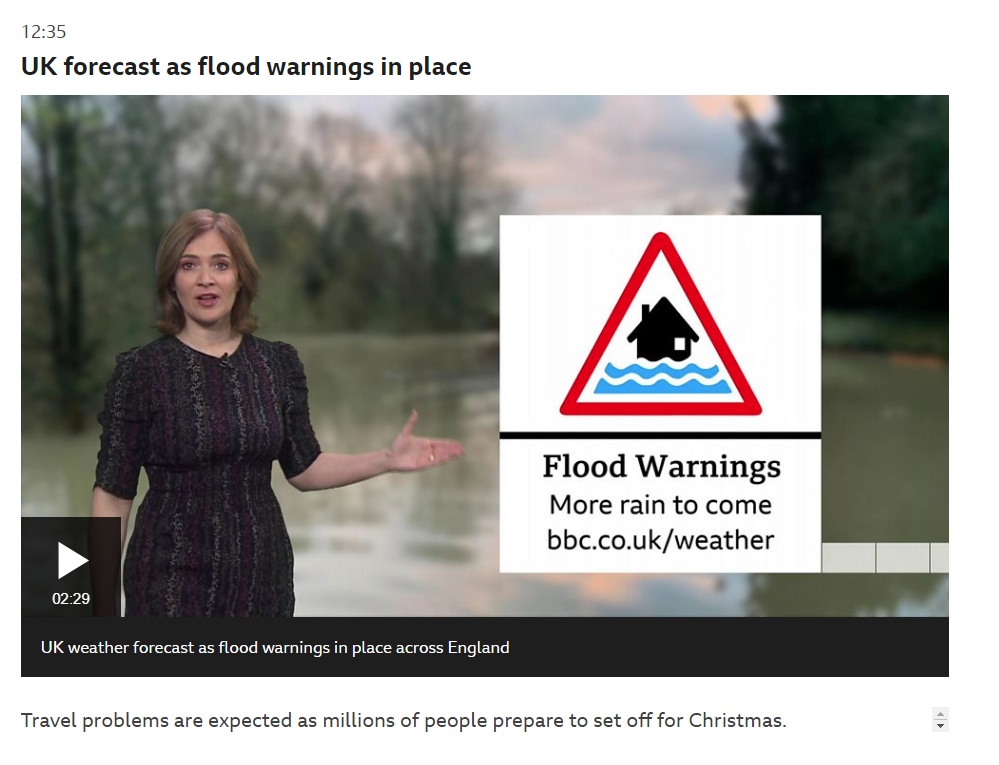
But for farmers, growers, fishermen, out doors enthusiasts and a number of others, having good information can help in decision making.
The current super computers are reasonably accurate out to three or four days. The longer range the forecast, the more variables that are introduced and the greater the chance for differences.
Following the question about forecasting, I saw that Dol was going to get rain overnight Thursday into Friday, so I decided to test the accuracy of the Wunderground forecast.

I also decided to look at the difference between my station (altitude 90 metres) and the one in Stari Grad (altitude 5 metres).
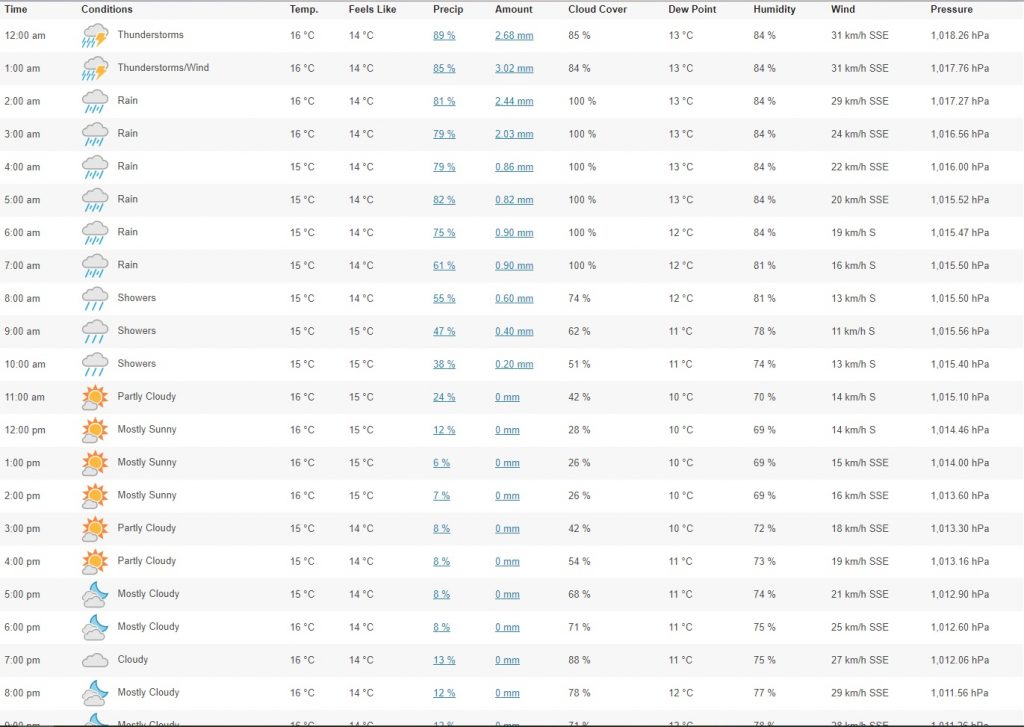
There was quite a bit of difference between the timing of the precipitation events, but in the end the total quantity of rainfall was very similar.
There were noticeable differences in the pulses of rainfall, indication that even over a short distance of 2.9 kilometres, the intensity varied.

Overall, the forecast was extremely accurate about when the rainfall would start, but underestimated the total value.
I watched on the Blitzortung website the first storm approaching from the west,.
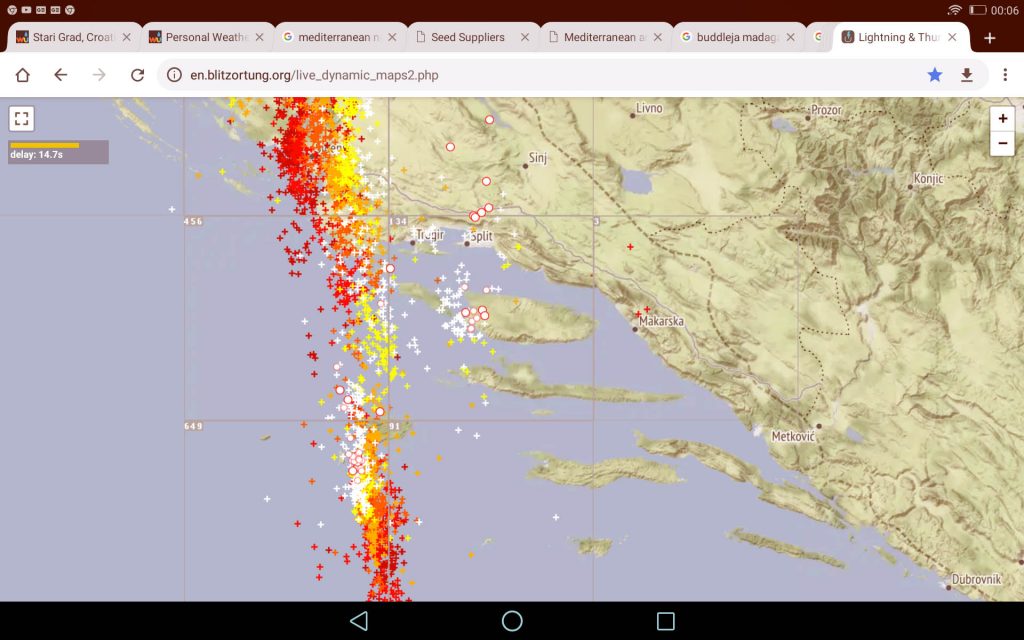
Then the second storm around dawn. Moving from west to east, and the island being aligned west-east, meant that the topography divided the small storm system, sending it mainly to the south.
Moving water around
On Friday morning we had a short period of heavy rain.
Between 11:12 and 11:36 we had 13.72 mm, followed by 2.4 mm until the rain stopped and the sun came out at 12:11.
So a total of 15.76 mm in an hour. When I stepped outside during the storm, my courtyard was completely flooded.

The peak rate was at the start of the storm when the rate peaked at 68.6 mm/hour. Of course it did not last for an hour – thank goodness!
The drain which takes water down to the orchard was working, but the volume of water that was falling meant it could barely cope. Part of this is because I have engineered my roof guttering so that I harvest all the precipitation and this is channelled via the courtyard drain to where it is needed.
I just wish I had my building work finished, so that I can lay the nice stone slabs in the courtyard, rather than just having a bed of sand and sandstone.

I also looked out at the fall pipe I installed a month back, to take water away from the roof of the Konoba building.

There was a veritable torrent issuing from the end of the spout and being directed safely away from my partially underground Konoba. I should have installed the guttering ages ago – but then I thought I would have had the new building finished!
These photographs do illustrate perfectly how when the soil surface is already sodden, additional rainfall has nowhere to go but as run-off.
Within half an hour, the courtyard was clear, if still a little soggy.
But back to today. It’s still raining, the felines are still asleep and I’m hungry! NRC
6 Responses
Michael
Happy Christmas Norman, from a very wet and soggy North Yorkshire where we’ve had more than 6 months’ average rainfall since mid-September. There will be no white Christmas this year in Sheriff!
Alan
Norman, Merry Christmas and a Happy New Year from a cooler and wetter southeast Arizona. Snow on the Huachucha Mountains to our south since before Thanksgiving (Nov 28th) and still some in higher shaded areas. During one of the storms a member of our Sheriff Assist Team recorded 2.65 inches over 24 hours, the most he’s seen in over 20 years.
Prediction is a white Christmas for Cochise County (high desert most famous for Tombstone shootout and Wyatt Earp)
Rob
Hi Norman, Belinda Abby and I wish you a very happy Christmas and best wishes for the New Year. It doesn’t stop raining here but, undoubtedly we will still have hose pipe bans next summer 😁
Dave
Merry Christmas Norm,from Wisconsin USA.
In November we had very cool weather with 16″ of snow. All this December we have had none and today it is 50 F which is about 20 degrees F over normal.I am looking forward to you getting your pond and landscaping done so you can start on a garden railroad!
I enjoy your monthly adventures.
Ray & Helen
Have a very Merry Christmas and a Healthy and Happy New Year. Raining and chilly at 45 F here in Tennessee with no chance of a white Christmas. Temp forecasted to be 61F on 25th.
Marcy Fletchall
Norman, I’m always grateful for the wonderful blog, the beautiful pictures and the lessons. I’ve learned so much. We have snow mounting, but no rain. We are expected to have snow flurries for Christmas Day. I wish you and your babies a very Merry Christmas. Enjoy the festivities with your neighbors.
Marcy